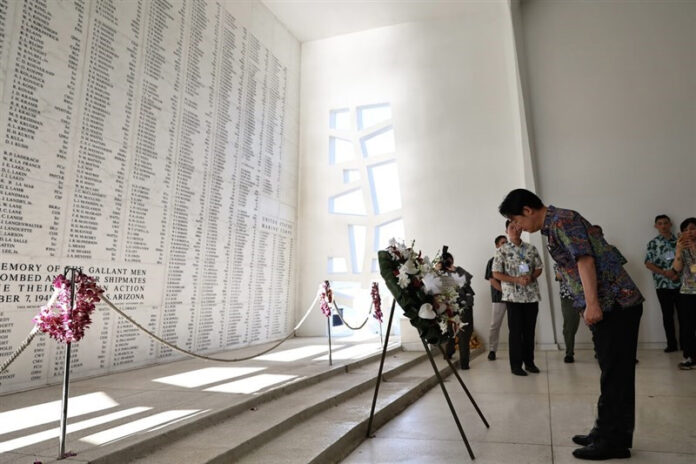President Lai’s U.S. Visit Reflects Shared Strategic Goals in Pacific Region
Taiwan’s President Lai Ching-te’s (賴清德) recent visit to Hawaii, including stops at the USS Arizona Memorial, Bishop Museum, and the Hawaii Emergency Management Agency, underscores a growing U.S.-Taiwan partnership with a shared objective to counter China’s increasing influence in the Indo-Pacific region. Scholars have weighed in on the significance of the visit, noting that it not only highlights the strength of Taiwan-U.S. relations but also points to a concerted effort to contain China’s maritime expansion.
The U.S. and Taiwan’s Joint Efforts to Contain China
Yeh Yao-yuan (葉耀元), an expert on international studies at the University of St. Thomas, pointed out that the visit to the USS Arizona Memorial at Pearl Harbor represents a critical symbol of U.S. strategic interests in the Pacific. Yeh stated that the visit emphasizes the U.S. and Taiwan’s mutual commitment to ensuring regional security and preventing Chinese expansionism.
The USS Arizona Memorial, which commemorates the 1941 Japanese attack on Pearl Harbor, holds a special significance in U.S. military history. Yeh emphasized that the U.S. has long maintained a strategic focus on the “first island chain,” a series of Pacific islands stretching from Japan to Taiwan. The U.S. has viewed this region as a key defensive line against potential threats from the sea, a policy that has been increasingly relevant given China’s growing naval power.
“President Lai’s visit to Pearl Harbor emphasizes the strategic partnership between Taiwan and the U.S. in resisting China’s attempts to expand its influence in the Pacific,” Yeh said. “This transit stop is more than symbolic; it is part of a broader strategy to maintain peace and deter aggression in the Taiwan Strait and beyond.”
Austronesian Heritage and Diplomatic Symbolism
The visit to Hawaii also carried cultural significance, with Lai visiting the Bishop Museum, which is renowned for its collections of Pacific cultural artifacts. Yeh noted that Taiwan’s Austronesian heritage, shared by many Pacific islands, forms an important part of Taiwan’s diplomatic outreach to the region.
“By visiting the Bishop Museum, the U.S. highlights Taiwan’s cultural ties to the Pacific islands, fostering deeper diplomatic relations with countries in the region,” Yeh explained.
Chen Fang-yu (陳方隅), an assistant professor of political science at Soochow University, echoed these sentiments, pointing out that Lai’s visit to the museum was not only a gesture of cultural exchange but also an opportunity to advance Taiwan’s public diplomacy initiatives.
“Taiwan is increasingly focused on promoting its rich Austronesian culture, and this visit underscores the importance of strengthening diplomatic ties with Pacific nations,” Chen said.
Strategic Significance: Enhancing Taiwan-U.S. Cooperation
Lai’s visit marks the continuation of Taiwan’s efforts to align more closely with the U.S. and like-minded nations in the Indo-Pacific region. Experts believe this diplomatic engagement is vital as Taiwan navigates a complex geopolitical landscape marked by China’s assertive actions in the South China Sea and beyond.
During his time in Hawaii, Lai also visited the Hawaii Emergency Management Agency, where he discussed disaster preparedness and mutual cooperation in dealing with natural disasters. These exchanges further illustrate Taiwan’s proactive approach to regional stability and its role in international humanitarian efforts.
Conclusion: Taiwan-U.S. Alliance Strengthened
As President Lai continues his trip to Taiwan’s Pacific allies, his stop in Hawaii serves as a clear reminder of the strategic importance of Taiwan’s alliances. Both in terms of security and cultural diplomacy, the visit reaffirms Taiwan’s commitment to regional peace and stability, while also demonstrating the united stance of the U.S. and Taiwan against the growing challenges posed by China.
Key Highlights of President Lai’s U.S. Transit Visit
| Event | Details |
|---|---|
| Date of Arrival | Saturday, [Date] |
| Location | Honolulu, Hawaii |
| Key Stops | USS Arizona Memorial, Bishop Museum, Hawaii Emergency Management Agency |
| Cultural Significance | Focus on Taiwan’s Austronesian heritage and ties with Pacific nations |
| Strategic Importance | Enhancing U.S.-Taiwan cooperation to deter China’s maritime expansion |
| Diplomatic Exchanges | Taiwan-U.S. relations, cultural diplomacy, regional security |
FAQs
1. What is the significance of President Lai’s visit to the USS Arizona Memorial?
- The visit to the USS Arizona Memorial symbolizes the strong partnership between Taiwan and the U.S., especially in light of China’s growing influence in the Pacific. It underscores both nations’ shared commitment to maintaining regional peace and security.
2. How does President Lai’s visit strengthen Taiwan’s relations with the Pacific region?
- By visiting the Bishop Museum, President Lai highlights Taiwan’s cultural ties to Pacific island nations and advances Taiwan’s public diplomacy. This visit fosters deeper diplomatic engagement with the region’s Austronesian heritage.
3. Why is the U.S. interested in Taiwan’s strategic location?
- Taiwan lies at the heart of the first island chain, which is crucial for U.S. defense strategy in the Pacific. The U.S. has long viewed Taiwan as an essential partner in countering threats, particularly from China’s maritime expansion.
